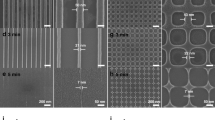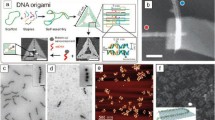Abstract
DNA-based nanofabrication of inorganic nanostructures has potential application in electronics, catalysis, and plasmonics. Previous DNA metallization has generated conductive DNA-assembled nanostructures; however, the use of semiconductors and the development of well-connected nanoscale metal—semiconductor junctions on DNA nanostructures are still at an early stage. Herein, we report the first fabrication of multiple electrically connected metal—semiconductor junctions on individual DNA origami by location-specific binding of gold and tellurium nanorods. Nanorod attachment to DNA origami was via DNA hybridization for Au and by electrostatic interaction for Te. Electroless gold plating was used to create nanoscale metal—semiconductor interfaces by filling the gaps between Au and Te nanorods. Two-point electrical characterization indicated that the Au—Te—Au junctions were electrically connected, with current—voltage properties consistent with a Schottky junction. DNA-based nanofabrication of metal—semiconductor junctions opens up potential opportunities in nanoelectronics, demonstrating the power of this bottom-up approach.

Similar content being viewed by others
Change history
16 June 2021
An Erratum to this paper has been published: https://doi.org/10.1007/s12274-021-3666-7
References
Liu, Y.; Guo, J.; Zhu, E. B.; Liao, L.; Lee, S. J.; Ding, M. N.; Shakir, I.; Gambin, V.; Huang, Y.; Duan, X. F. Approaching the Schottky-Mott limit in van der Waals metal-semiconductor junctions. Nature 2018, 557, 696–700.
Liu, Y. Y.; Stradins, P.; Wei, S. H. Van der Waals metal-semiconductor junction: Weak Fermi level pinning enables effective tuning of Schottky barrier. Sci. Adv. 2016, 2, e1600069.
Al-Ta’ii, H. M.; Periasamy, V.; Amin, Y. M. Electronic properties of DNA-based Schottky barrier diodes in response to alpha particles. Sensors 2015, 15, 11836–11853.
Dutta, S. K.; Mehetor, S. K.; Pradhan, N. Metal semiconductor heterostructures for photocatalytic conversion of light energy. J. Phys. Chem. Lett. 2015, 6, 936–944.
Al-Ta’ii, H. M. J.; Periasamy, V.; Amin, Y. M. Detection of alpha particles using DNA/Al Schottky junctions. J. Appl. Phys. 2015, 118, 114502.
Ye, J. J.; Helmi, S.; Teske, J.; Seidel, R. Fabrication of metal nano-structures with programmable length and patterns using a modular DNA platform. Nano Lett. 2019, 19, 2707–2714.
Hui, L. W.; Zhang, Q. M.; Deng, W.; Liu, H. T. DNA-based nanofabrication: Pathway to applications in surface engineering. Small 2019, 15, 1805428.
Halley, P. D.; Patton, R. A.; Chowdhury, A.; Byrd, J. C.; Castro, C. E. Low-cost, simple, and scalable self-assembly of DNA origami nanostructures. Nano Res. 2019, 12, 1207–1215.
Rothemund, P. W. K. Folding DNA to create nanoscale shapes and patterns. Nature 2006, 440, 297–302.
Liu, J. F.; Geng, Y. L.; Pound, E.; Gyawali, S.; Ashton, J. R.; Hickey, J.; Woolley, A. T.; Harb, J. N. Metallization of branched DNA origami for nanoelectronic circuit fabrication. ACS Nano 2011, 5, 2240–2247.
Chen, Z. W.; Liu, C. Q.; CaO, F. F.; Ren, J. S.; Qu, X. G. DNA metallization: Principles, methods, structures, and applications. Chem. Soc. Rev. 2018, 47, 4017–4072.
Uprety, B.; Westover, T.; Stoddard, M.; Brinkerhoff, K.; Jensen, J.; Davis, R. C.; Woolley, A. T.; Harb, J. N. Anisotropic electroless deposition on DNA origami templates to form small diameter conductive nanowires. Langmuir 2017, 33, 726–735.
Uprety, B.; Jensen, J.; Aryal, B. R.; Davis, R. C.; Woolley, A. T.; Harb, J. N. Directional growth of DNA-functionalized nanorods to enable continuous, site-specific metallization of DNA origami templates. Langmuir 2017, 33, 10143–10152.
Geng, Y. L.; Pearson, A. C.; Gates, E. P.; Uprety, B.; Davis, R. C.; Harb, J. N; Woolley, A. T. Electrically conductive gold- and copper-metallized DNA origami nanostructures. Langmuir 2013, 29, 3482–3490.
Hossen, M. M.; Bendickson, L.; Palo P. E.; Yao, Z. Q.; Nilsen-Hamilton, M.; Hillier, A. C. Creating metamaterial building blocks with directed photochemical metallization of silver onto DNA origami templates. Nanotechnology 2018, 29, 355603.
Shen, B. X.; Linko, V.; Tapio, K.; Kostiainen, M. A.; Toppari, J. J. Custom-shaped metal nanostructures based on DNA origami silhouettes. Nanoscale 2015, 7, 11267–11272.
Maune, H. T.; Han, S. P.; Barish, R. D.; Bockrath, M.; Goddard III, W. A.; Rothemund, P. W. K.; Winfree, E. Self-assembly of carbon nanotubes into two-dimensional geometries using DNA origami templates. Nat. Nanotechnol. 2010, 5, 61–66.
Mangalum, A.; Rahman, M.; Norton, M. L. Site-specific immobilization of single-walled carbon nanotubes onto single and one-dimensional DNA origami. J. Am. Chem. Soc. 2013, 135, 2451–2454.
Bayrak, T.; Helmi, S.; Ye, J. J.; Kauert, D.; Kelling, J.; Schönherr, T.; Weichelt, R.; Erbe, A.; Seidel, R. DNA-mold templated assembly of conductive gold nanowires. Nano Lett. 2018, 18, 2116–2123.
Aryal, B. R.; Westover, T. R, Ranasinghe, D. R.; Calvopiña, D. G.; Uprety, B.; Harb, J. N.; Davis, R. C.; Woolley, A. T. Four-point probe electrical measurements on templated gold nanowires formed on single DNA origami tiles. Langmuir 2018, 34, 15069–15077.
Weichelt, R.; Ye, J. J.; Banin, U.; Eychmüller, A.; Seidel, R. DNA-mediated self-assembly and metallization of semiconductor nanorods for the fabrication of nanoelectronic interfaces. Chem.—Eur. J. 2019, 25, 9012–9016.
Zhu, H. T.; Zhang, H.; Liang, J. K.; Rao, G. H., Li, J. B.; Liu, G. Y.; Du, Z. M.; Fan, H. M.; Luo, J. Controlled synthesis of tellurium nanostructures from nanotubes to nanorods and nanowires and their template applications. J. Phys. Chem. C 2011, 115, 6375–6380.
Gautam, U. K.; Rao, C. N. R. Controlled synthesis of crystalline tellurium nanorods, nanowires, nanobelts and related structures by a self-seeding solution process. J. Mater. Chem. 2004, 14, 2530–2535.
Goldfarb, R. Tellurium—The Bright Future of Solar Energy; U.S. Department of the Interior, U.S. Geological Survey, 2014.
He, Z.; Yang, Y.; Liu, J. W.; Yu, S. H. Emerging tellurium nanostructures: Controllable synthesis and their applications. Chem. Soc. Rev. 2017, 46, 2732–2753.
Zhu, Y. J.; Wang, W. W.; Qi, R. J; Hu, X. L. Microwave-assisted synthesis of single-crystalline tellurium nanorods and nanowires in ionic liquids. Angew. Chem., Int. Ed. 2004, 43, 1410–1414.
Wang, Q.; Li, G. D.; Liu, Y. L.; Xu, S.; Wang, K. J.; Chen, J. S. Fabrication and growth mechanism of selenium and tellurium nanobelts through a vacuum vapor deposition route. J. Phys. Chem. C 2007, 111, 12926–12932.
Riley, B. J.; Johnson, B. R.; Schaef, H. T.; Sundaram, S. K. Sublimation-condensation of multiscale tellurium structures. J. Phys. Chem. C 2013, 117, 10128–10134.
Yang, H. R.; Finefrock, S. W.; Caballero, J. D. A.; Wu, Y. Environmentally benign synthesis of ultrathin metal telluride nanowires. J. Am. Chem. Soc. 2014, 136, 10242–10245.
Ali, M. R. K.; Snyder, B.; El-Sayed, M. A. Synthesis and optical properties of small Au nanorods using a seedless growth technique. Langmuir 2012, 28, 9807–9815.
Liu, K.; Zheng, Y. H.; Lu, X.; Thai, T.; Lee, N. A.; Bach, U.; Gooding, J. J. Biocompatible gold nanorods: One-step surface functionalization, highly colloidal stability, and low cytotoxicity. Langmuir 2015, 31, 4973–1980.
Herdt, A. R.; Drawz, S. M.; Kang, Y.; Taton, T. A. DNA dissociation and degradation at gold nanoparticle surfaces. Colloids Surf B Biointerfaces 2006, 51, 130–139.
Geier, B.; Gspan, C.; Winkler, R.; Schmied, R.; Fowlkes, J. D.; Fitzek, H.; Rauch, S.; Rattenberger, J.; Rack, P. D.; Plank, H. Rapid and highly compact purification for focused electron beam induced deposits: A low temperature approach using electron stimulated H2O reactions. J. Phys. Chem. C 2014, 118, 14009–14016.
Ananthakumar, S.; Ramkumar, J.; Babu, S. M. Facile synthesis and transformation of Te nanorods to CdTe nanoparticles. Mat. Sci. Semicon. Proc. 2014, 27, 12–18.
Uprety, B.; Gates, E. P.; Geng, Y. L.; Woolley, A. T.; Harb, J. N. Site-specific metallization of multiple metals on a single DNA origami template. Langmuir 2014, 30, 1134–1141.
Lin, Z. H.; Lin, Y. W.; Lee, K. H.; Chang, H. T. Selective growth of gold nanoparticles onto tellurium nanowires via a green chemical route. J. Mater. Chem. 2008, 18, 2569–2572.
Acknowledgements
We thank the National Science Foundation (No. 1562729) and BYU’s Simmons Research Endowment for support of this work. B. R. A. acknowledges the BYU Department of Chemistry and Biochemistry for a Roland K. Robins Graduate Research Fellowship.
Author information
Authors and Affiliations
Corresponding author
Electronic Supplementary Material
Rights and permissions
About this article
Cite this article
Aryal, B.R., Ranasinghe, D.R., Westover, T.R. et al. DNA origami mediated electrically connected metal—semiconductor junctions. Nano Res. 13, 1419–1426 (2020). https://doi.org/10.1007/s12274-020-2672-5
Received:
Revised:
Accepted:
Published:
Issue Date:
DOI: https://doi.org/10.1007/s12274-020-2672-5




